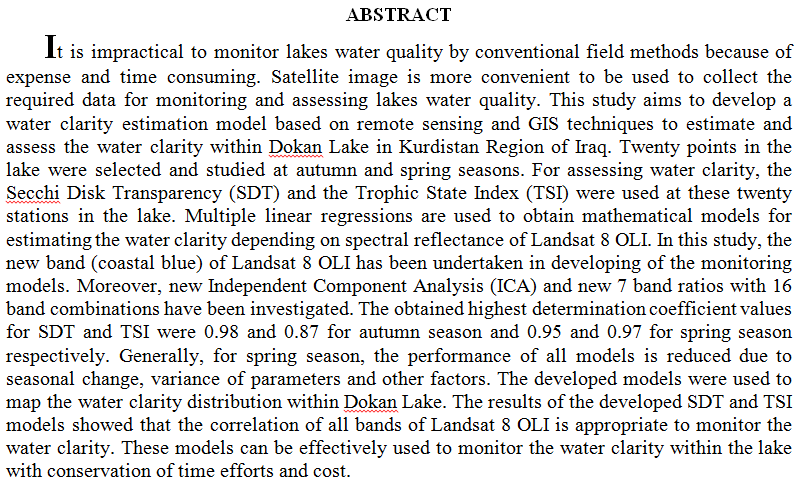
 (2)
(2)
 (2)
(2)
 (3)
(3)
The present work aims to study the efficiency of coagulation/ flocculation as 1st stage, natural gravity water filter or microfiltration (MF) as 2nd stage and nanofiltration (NF) technology as final stage for treatment of water of main outfall drain (MOD) for injection in Nasiriyah oil field. Effects of operating parameters such as coagulant dosage, speed and time of slow mixing step and settling time in the 1st stage were studied. Also feed turbidity and total suspended solids (TSS) in the 2
... Show MoretA novel synthesis procedure is presented for preparing triethanolamine-treated graphene nanoplatelets(TEA-GNPs) with different specific areas (SSAs). Using ultrasonication, the covalently functionalizedTEA-GNPs with different weight concentrations and SSAs were dispersed in distilled water to prepareTEA-GNPs nanofluids. A simple direct coupling of GNPs with TEA molecules is implemented to synthesizestable water-based nanofluids. The effectiveness of the functionalization procedure was validated by thecharacterization and morphology tests, i.e., FTIR, Raman spectroscopy, EDS, and TEM. Thermal conduc-tivity, dispersion stability, and rheological properties were investigated. Using UV–vis spectrometer, ahighest dispersion stability of 0.876
... Show More (93)
(93)
Field experiment was conducted to test the effect of saline water and fertilizers rate on Pisum sativum L. plants . Treatments of the experiment included two levels of water salinity (2, 7 dSm-1) as a main plot and three levels of potash fertilization K2SO4 (44%K) namely 150 control, 300 and 450 kg/Donum as a sub plot. Results indicated that irrigation of plant with saline water 7 dSm-¹ caused a significant decrease in K and P contents specially in the upper parts of the plants , the percentage of the K increased (2.80%) under 2 dSm-¹of irrigation water and 300 kg/ donum fertilizer rate in the upper leaves, However K decreased(1.10%) in lower leaves under 7 dSm-¹ and 300 kg/donum fertilizer. while P increased in pods und
... Show MoreThe purpose of this paper is to build a simulation model by using HEC-RAS software to simulate the reality of water movement in the main river of Basra City (South of Iraq) which is known as Siraji-Khoura River. The main objective of the simulation is to detect areas where the water cycle is interrupted in some stations of the river stream, as this river has become an outlet for the disposal of sewage, leading to pollution and causing weakness in some sections of the river & obstructing the water cycle that takes place between this river and Shatt al – Arab river. A field survey data of the river and its banks were adopted to derive the grades, longitudinal and cross sections of the river, these data included three-dimensional coordinates
... Show More (6)
(6)
 (1)
(1)
 (14)
(14)
 (10)
(10)
 (8)
(8)
The service system has become a necessity of life in modern cities to be the most basic necessities of modern humans, they constitute a major base, which is based on the sustainability of life in the city and a standard measured through the degree of well-being and progress of civilized peoples and their interaction with the surrounding environment, making the services sector as a need not be an option, whenever the cities widened in population and space whenever provision of services and upgrading the quality and quantity more pressing, which made the subject of the services takes the biggest area of the trends and thinking of urban planners and those who in charge of drawing the cities policies. Consideri
... Show More
